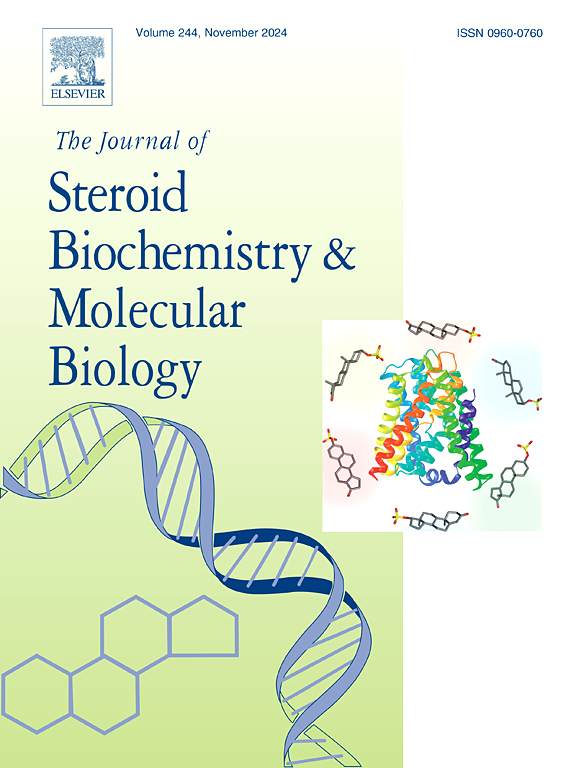Confirmation of a novel, stable estrogen metabolite, as 5a,6a-epoxy-estrone sulfate in stallion blood by LC-MS/MS
IF 2.5
2区 生物学
Q3 BIOCHEMISTRY & MOLECULAR BIOLOGY
Journal of Steroid Biochemistry and Molecular Biology
Pub Date : 2025-05-20
DOI:10.1016/j.jsbmb.2025.106788
引用次数: 0
Abstract
Mass spectrometry (MS) has become pivotal for accurately delineating intricate molecular structures for steroids present in minute quantities within biological samples. This study utilized liquid chromatography-high resolution tandem mass spectrometry (LC-HRMS/MS) to identify and characterize a ‘new’ estrogen metabolite, 5α,6α-epoxy-estrone sulfate, in stallion serum from three animals. The estrogen structure was predicted previously using radiolabeled steroids. HRMS/MS, in combination with a seamless sample preparation involving liquid-liquid extraction and chromatographic separation, enabled accurate mass spectrometric identification of the target metabolite. A distinct chromatographic peak corresponding to the metabolite displayed a fragmentation pattern consistent with its predicted structure. Fragment ions at m/z 79.9 and 285.1 resulting from precursor ion m/z 365.5 [M-H]- suggested the presence of a sulfated group and epoxy form of estrone, with an additional oxygen atom when compared with those for a reference standard of estrone sulfate. The assignment of other fragment ions from the target ion further elucidated the predicted structure. Evidence for a structure unique from any other estrogen metabolite on record was demonstrated on two different LC-QTOF instruments. Its identification in the blood circulation ensures distribution throughout the body. The potential significance for future physiological/pathological investigations is discussed.
用LC-MS/MS确认种马血液中一种新的稳定雌激素代谢物——硫酸5a,6a-环氧雌酮。
质谱法(MS)已成为准确描绘生物样品中微量类固醇复杂分子结构的关键。本研究利用液相色谱-高分辨率串联质谱(LC-HRMS/MS)技术,从3种动物的种马血清中鉴定并表征了一种“新的”雌激素代谢物——5α,6α-环氧-硫酸雌酮。雌激素结构以前是用放射性标记的类固醇来预测的。HRMS/MS结合液-液萃取和色谱分离的无缝样品制备,实现了目标代谢物的准确质谱鉴定。代谢物对应的色谱峰显示出与其预测结构一致的破碎模式。前体离子m/z 365.5 [m - h]-在m/z 79.9和285.1处产生的碎片离子表明存在硫酸化基团和环氧形式的雌酮,与参考标准的硫酸雌酮相比,多了一个氧原子。来自目标离子的其他碎片离子的分配进一步阐明了预测的结构。在两种不同的LC-QTOF仪器上证明了一种结构独特于任何其他记录的雌激素代谢物的证据。它在血液循环中的识别确保了它在全身的分布。讨论了未来生理/病理研究的潜在意义。
本文章由计算机程序翻译,如有差异,请以英文原文为准。
求助全文
约1分钟内获得全文
求助全文
来源期刊
CiteScore
8.60
自引率
2.40%
发文量
113
审稿时长
46 days
期刊介绍:
The Journal of Steroid Biochemistry and Molecular Biology is devoted to new experimental and theoretical developments in areas related to steroids including vitamin D, lipids and their metabolomics. The Journal publishes a variety of contributions, including original articles, general and focused reviews, and rapid communications (brief articles of particular interest and clear novelty). Selected cutting-edge topics will be addressed in Special Issues managed by Guest Editors. Special Issues will contain both commissioned reviews and original research papers to provide comprehensive coverage of specific topics, and all submissions will undergo rigorous peer-review prior to publication.

 求助内容:
求助内容: 应助结果提醒方式:
应助结果提醒方式:


